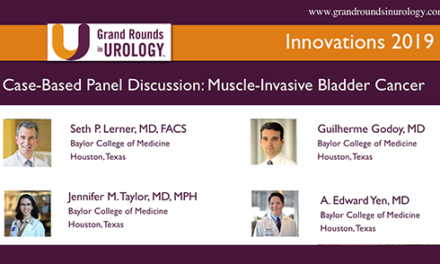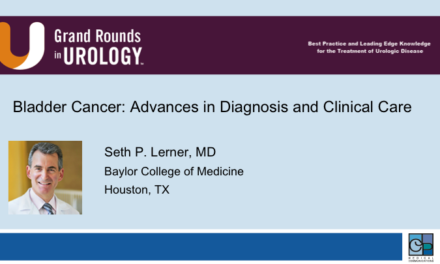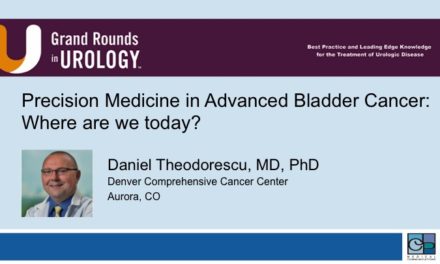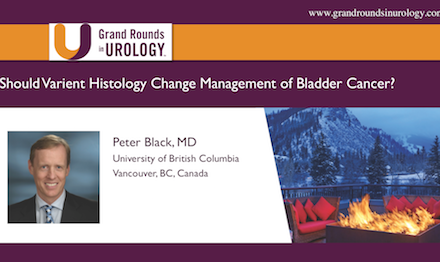Dr. Robert Abouassaly, MD, presented “Can the DECIPHER Marker Predict Chemotherapy?” at the 26th Annual Perspectives in Urology: Point-Counterpoint, November 10, 2017 in Scottsdale, AZ
How to cite: Abouassaly, Robert “Can the DECIPHER Marker Predict Chemotherapy?” November 10, 2017. Accessed Jan 2025. https://dev.grandroundsinurology.com/can-decipher-marker-can-predict-chemotherapy/
Summary:
Robert Abouassaly, MD, argues that the DECIPHER marker is not an ideal test for predicting patient’s response to chemotherapy. He cites the inconclusiveness of trials and research and the cost inefficiency of this biomarker. Also, he explains that the DECIPHER test’s classification system is based on RNA expression profiles, and not meant for therapeutic guidance. This is a counter argument to Alan H. Bryce’s lecture, “The DECIPHER Marker Can Predict Chemotherapy.”
Can the DECIPHER Marker Predict Chemotherapy?
Transcript:
So there is little doubt that precision medicine is the future of oncology. Looking at a patient’s expression profile and genetic profile to determine what treatments would be best for that patient. The problem is in urologic malignancy, that science is lagging. I know this is not a rigorous way to evaluate it, but if you did a PubMed search for mutational biology and you put in breast cancer, you would get 475 citations. But if you did the same thing for bladder cancer you would only get 58, so just telling you how far we still have to go in this field.
That being said, there have been publications that have looked at certain mutations in its correlation with outcomes with chemotherapy. The paper on the left is in Cancer Discovery in 2014, and this was a Phase 1 trial of Everolimus and pazopanib in patients with advanced solid cell tumors, and what they noticed was in bladder cancer patients with activating MTOR mutations they responded extremely well. The figure on the right is from JAMA Oncology last year, and it looked at bladder cancer patients being treated with neoadjuvant chemotherapy cisplatin based that either did or did not have the ERCC2 mutation and what they found is that patients with the ERCC2 mutations responded far better than those who did not. That being said only 40% of patients with that—that responded to the chemotherapy had that mutation so the majority of the patients who responded to chemotherapy were ERCC2 negative. So the applicability of this remains to be determined.
So in general single gene mutation is probably not he way to go because it only takes into account one aspect and doesn’t look at the complex genetic interactions that one might have in malignancy and would only be applicable to a small subset of patients.
So the DECIPHER bladder test, which is currently approved, and you could order this if you wanted, is marketed for patients who are candidates for cystectomy, and it looks for RNA expression in 149 genes. What it does is it breaks down the patients into four bladder molecular sub-types, luminal, luminal infiltrated, basal, and basal clotted low, and when they looked at these response to chemotherapy they found that the basal types had improved survival with neoadjuvant chemotherapy compared to radical cystectomy patients with the basal type who did not receive neoadjuvant chemotherapy. Now, this was not a randomized trial. These were two separate groups of patient. Now, the data for the DECIPHER test comes mostly from this paper published in European Urology in March of this year, and it is an excellent paper, and what they did is they looked at whole transcriptome profiling in 343 TUR specimens, and they classified these tumors into the four molecular sub-types that I mentioned. Using the profile information they developed the genomic sub-typing classifiers to predict sub-types in the context of neoadjuvant chemotherapy. They then looked at overall survival according to sub-type, and compared it to a separate group of patients 475 patients who did not receive neoadjuvant chemotherapy.
They also looked at the ability of the test to predict the sub-groups, and they go a reasonable accuracy of 73% with an area under the curve of 0.85. That being said, that is the accuracy of the test to predict sub-type, not the accuracy of the test to predict response to chemotherapy, which is what clinicians really need to know to make the decision on the utility of a test.
So what are the limitations of the study? Well, the original classification was not meant to be based on outcomes. It was just based on RNA expression profiles. Further, it was developed mostly in cystectomy patients, later translated to TUR specimens, but again originally developed sub-classification in cystectomy patients, and these were originally patients who did not receive neoadjuvant chemotherapy, and although the basal group performed better after neoadjuvant chemotherapy, interestingly there was no association with major response to chemotherapy. So they did not have a higher rate of pathologic T0 for example, which is unusual. Also, the publication doesn’t tell us what is the positive predictive value or the negative predictive value of that test for response to chemotherapy, because that is what clinicians need to know.
Finally, they only looked at response to cisplatin-based chemotherapy, not any of the other treatments, which are available.
Also, what is important to know is what is the number needed to test, so how many patients do I have to run this test on for it to be useful? Well, in the original publication, the basal sub-type comprised only 30 to 35% of patients. Not all basal sub-types will respond to neoadjuvant chemotherapy and as previous studies have shown, not every patient who may otherwise have been a candidate for neoadjuvant chemotherapy receive it because of either renal insufficiency, medical comorbidity or patient refusal.
Further, there is no consensus on the molecular sub-typing that the DECIPHER test currently uses, and actually this paper in Cell just two months ago divides bladder cancer into five molecular sub-types, which includes a neuronal type.
And this nice review in European Urology again very recently stated that it should be emphasized that our understanding of the biological and clinical properties of the molecular sub-types of bladder cancer is still fairly limited, and we do not yet know whether the molecular sub-type membership is a stable, intrinsic feature of a given tumor. In other words, is it the same over time, or after treatment or does it change? Also, this paper in Journal of Pathology says that molecular sub-typing alone is probably insufficient, and you probably should combine that with immunohistochemical information.
Also, we should not use these tests in isolation. What we need to do is build composite risk models that help us determine and make clinical decisions. So this would allow us to capture the complex inter-dependent interactions between distinct gene mutations, and these composite risk models would include clinical factors, germ line polymorphism, disease related alteration such as proteome and metabolome information as well as micro-environment related factors such as cytokine and infiltrating immune cells.
This will allow us to determine what additional benefit that test has over what we currently have clinically available, and that information is what we need to determine the utility of a test.
The original study validated this sub-classification in a group of patients just under 100 patients, and we know that validating in a single cohort is probably inadequate, it needs to be prospectively validated, it needs to be looked at in a wide variety of patients to ensure that the algorithm is robust in a range of different patient populations.
Also, we need to take into account the potential genetic drift that occurs with treatment, so would this have to be retested multiple times? Also, we have to make sure that the validation test was adequately powered. This nice figure in publication in Blood shows and helps us determine if a validation study was adequately powered based on the observed hazard ratio, the number of events seen, as well as a fraction of positive cases. So if you do this for the validation study of the DECIPHER publication, it falls in this area, which suggests that it may have been under powered, and the authors acknowledge that.
Also, what about tissue sampling, DNA, RNA, from paraffin embedded TUR specimens, may be fragmented or chemically modified. TUR specimens may not fully represent the spatial heterogeneity and clonal hierarchichies of the disease as a whole. Also, in parallel to prognostic models and tests, we need to develop therapeutics in bladder cancer which is lacking, and so the development of patient selection needs to move in parallel with these therapeutic developments.
Finally, I’ll talk briefly about cost, and the outrageous cost of these genetic tests. This nice article in the New York Times from a few years ago, talked about the cost of the testing for BRCA1 mutation and how patients and society in our healthcare system will pay for these expensive tests. And although cost-effectiveness for the use of DECIPHER in bladder cancer has not been performed, it has been performed in a publication recently in prostate cancer, so they used the Markoff model and assumed an assay cost of $4,000. They compared its use to help in the decision making post-prostatectomy to decide if patients are going to receive adjuvant radiation or not, and they compared it to a scenario where 100% of patients received adjuvant radiation, which is far from what is currently being practiced, and they demonstrated that if you did that, you would demonstrate an average cost savings of $11,400. But if you compared it to usual care in which only 7% of men received adjuvant radiation, you only get a benefit of 24 days quality adjusted lifetime, which would translate into a cost of $90,000 for each quality adjusted life year, which is above the threshold of $50,000, which is generally accepted as cost-effective, and the test would have to be less than $1,500 to satisfy that threshold.
Also, we have to take into account biases that could exist in publications. This article in JAMA from several years ago showed that if a study is funded by a for-profit organization, it was five times more likely to recommend that treatment compared to not publications and studies funded by not-for-profit organizations, and we just need to take that into account, and the study did have a few disclosures to mention.
So in summary the classification system that the decipher test uses was not developed for therapeutic guidance. Molecular lung function is evolving and has already been shown to be changing over time, and so we’re not sure if the classification currently used by the test is still valid. It has also not been validated prospective or in large diverse populations and we don’t know the performance characteristics of that test, and we need that information as clinicians to decide if it is useful to us.
Also, information from the GCS needs to be added to composite risk models so we can determine how much additional information it actually provides to see if it is worth the added cost of the test, and of course as I mentioned we need to continue to develop therapeutics in bladder cancer so we have more tools in our armamentarium to use this information, and finally it hasn’t been shown to be cost-effective.
So probably the strongest argument for not using this test today is the concluding statement from the publication that helped develop the test, and they state, “These findings require prospective validation before this single sample classifier can be used in clinical practice.” So although our understanding of bladder cancer is improving over time, I think it is still just the tip of the iceberg. Thank you.
ABOUT THE AUTHOR
Dr. Abouassaly is an Associate Professor of Urology at the Cleveland Clinic in Cleveland, Ohio. He received his medical degree from the McGill University Faculty of Medicine in Montreal, Canada, in 2002. Dr. Abouassaly then went on to complete residencies in Surgery and Urology at the Cleveland Clinic, followed by a Fellowship in Urologic Oncology at the University of Toronto Faculty of Medicine.
He specializes in urology and has published widely about such urologic subjects as nephrectomy, prostate biopsy, and laparoscopic and robotic procedures. In addition to the Cleveland Clinic, Dr. Abouassaly is affiliated with University Hospitals Cleveland Medical Center and University Hospitals Richmond Medical Center.





